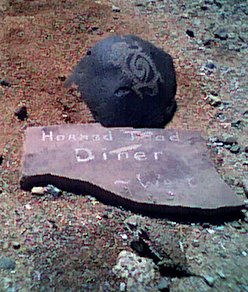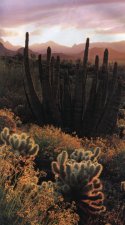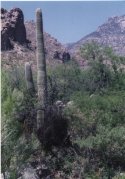
...SLOW DOWN!!!...
when you drive! Many animals (and people, too, for that matter!) are killed each day on our roads by speeding drivers. This is esecially a concern for us here in Southeast Arizona as we have so many well- travelled roads slicing through open desert, National Parks (like Saguaro), and wildlife preserves. I was really glad to see that this issue has become of such concern that Tucson Newspapers, as well as a local tv news affiliate, have done stories on it in recent weeks. Biologists recently completed a study which determined that 7,100 animals died on the road in Saguaro National Park last year. And these were not just the ubiquitous rabbits and coyotes; no, these included spadefoot toads, tortoises, birds of prey, bobcats, and so on. Living up here in Catalina, where we have a real urban/desert interface, so to speak, I've personally witnessed a lot of this, maybe more than most people because I'm out on the roads around here every day with my horses. The view at a leisurely pace from the back of a horse allows one to take in a lot of detail in the surrounding landscape..and many times on the road I've seen something I wish I hadn't! We don't use our truck much: about once a week to go to Tucson (in Catalina we use our horses and bicycles)- but when we do get in the truck we always remember there's many others on the road besides ourselves: we leave earlier, drive slower, and remain alert. Won't you do the same?
Did you know?...The San Pedro Riparian National Conservation Area (north and east of Sierra Vista) has 86 mammal species- more than any similar-sized area in the United States.

"Why can't I just go out in the desert and dig up whatever plants I want to?".....This is often accompained by "I only want one..." (or "a few")! I hear this question from at least a couple hundred people a year! And this is where I launch into my empassioned plea: "Please don't!"...Nothing exists in a vacuum: the individual plants and animals in the desert are no exception- all of them are dependent upon each other: remove one mesquite tree, and you've removed a nursemaid tree whose shade is needed by over 100 different plant species when those species are in their infancy (including Saguaro cacti)! Not to mention the fact that numerous birds and mammals use that same tree for nesting and roosting. Remove one barrel cactus, and you've deprived birds, ground squirrels, and various insects of an important food source: the blossoms and the fruits that follow. These are there in the heat of summer, when other food and moisture sources are low. Another important factor here is the rate at which our desert is vanishing due to development- we are at a point where every bit that we can preserve: every plant, every animal- should be left alone, saved, cherished. What a shame it would be to have what makes this place so special, vanish. And lastly, for those who would heed nothing else, taking native plants (and animals) out of the desert is against the law, with stiff penalties (even jail time) for those who do.
Did You Know?.....cactus poaching has caused over a 40% decline in the already endangered Thornber's fishhook cactus?
"Why can't I go out and collect cactus wood?" (Saguaro ribs and cholla skeletons.) "After all- they're already dead!".....This question IS related to the one above, and it has to do with animal food and animal habitat- many insect, reptile, and small mammal species use downed desert plants for homes, raising their young in them. Many insect species also eat the decaying plant material, hastening it's transformation into "desert compost" that enriches the desert soil and feeds new young plants- the descendants of the old plants that died. And the cycle of life continues. By the way, yes, the law does allow the careful collecting of strictly regulated amounts of cactus wood (and certain live plants also)- this means obtaining a permit from the state (for info on laws and permits, see my "Links" page, or e-mail me and I'll send you the info). Won't you please help preserve our desert?
E-MAIL Me
with your questions. I promise to reply (please give me a few days. 'tho!). And if I get the same question often enough, why...that's one I'll add to this page!
Left: Organ Pipe Cactus National Monument. Right; Saguaro in Ventana Canyon.


|
Arid Lands and the Plants That Make Their Homes There: The introduction to the plant pages. Cactus Care: Information on light requirements, transplanting, feeding, watering, etc. Caring for Traditional Herbs in the Desert: Help in raising non-native (but very useful) herbs such as mints, thymes, and scented geraniums in our desert climate. Desert Plants: Shrubs; Ocotillos; etc.: Information on caring for drought- tolerant natives and non- natives; perennial wildflowers, too! The Sonoran Desert and Her Plants: Back to the Home Page Turtle Woman Site Archive: Back to the OLD Home Page |